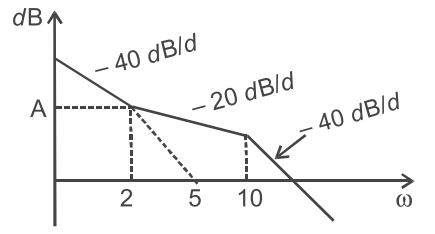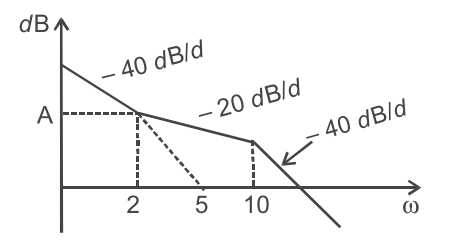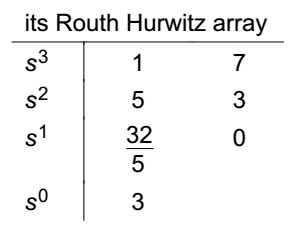Control systems miscellaneous
- A unity feedback control system has a forward path transfer function equal to 42·25/s(s + 6·5) The unit step response of this system starting from rest, will have its maximum value at a time equal to—
-
View Hint View Answer Discuss in Forum
Given C(s) = 42·25 R(s) s(s + 6·5)
If r(t) = u(t)
then
R(s) = 1/s
andC(s) = R(s)· 42·25 s(s + 6·25)
orC(s) = 1 × 42·25 s2 s(s + 6·25)
orC(s) = A + B + C s s2 s + 0·6s
orC(s) = – 1 + 6·5 + 1 s s2 (s + 6·5)
(by using partial fractions) By taking inverse Laplace transform
C(t) = – u(t) + tu(t) + e–6·5t
response at steady state means C(t) as t → ∞
i.e., C(t) = ∞
Hence alternative (D) is the correct choice.Correct Option: D
Given C(s) = 42·25 R(s) s(s + 6·5)
If r(t) = u(t)
then
R(s) = 1/s
andC(s) = R(s)· 42·25 s(s + 6·25)
orC(s) = 1 × 42·25 s2 s(s + 6·25)
orC(s) = A + B + C s s2 s + 0·6s
orC(s) = – 1 + 6·5 + 1 s s2 (s + 6·5)
(by using partial fractions) By taking inverse Laplace transform
C(t) = – u(t) + tu(t) + e–6·5t
response at steady state means C(t) as t → ∞
i.e., C(t) = ∞
Hence alternative (D) is the correct choice.
- For the given Bode plot the value of K–

-
View Hint View Answer Discuss in Forum
From given figure we conclude that first we must find gain in dB at point A in order to calculate the value of K
40 = A(in db) log(5/2)
orA (dB) = 40 log 5 = 15.9 2
Now,20 log K |at s=2 = 15.9 s2
orK |at s=2 = 1015.9/20 s2
or
K = 22 × 6·23 = 24·949
Hence alternative (A) is the correct choice.
Correct Option: A
From given figure we conclude that first we must find gain in dB at point A in order to calculate the value of K
40 = A(in db) log(5/2)
orA (dB) = 40 log 5 = 15.9 2
Now,20 log K |at s=2 = 15.9 s2
orK |at s=2 = 1015.9/20 s2
or
K = 22 × 6·23 = 24·949
Hence alternative (A) is the correct choice.
- If the closed-loop transfer function of unity negative feedback system is given by
T(s) = an-1 s+an sn + a1sn-1 + ........+an-1s+an
then the steady state error for a unit ramp is—
-
View Hint View Answer Discuss in Forum
GivenT.F. = G(s) 1 + G(s) H(s) = an-1 s+an sn + a1sn-1 + ........+an-1s+an
orG(s) = an-1 s+an 1 + G(s) sn + a1sn-1 + ........+an-1s+an
[∴ H(s) = 1]
[1 + G(s)an – 1 s + an] = G(s) [sn + a1 sn–1 + a2 sn – 2 … + an– 1 s + an]
or
an = G(s) [sn + a1sn–1 + a2 sn–2 + … + an–2s2]
orG(s) = an [sn + a1 sn–1 + a2 sn–2 + … + an–2 s2]
Now,
ess = s → 0Lim R(s) 1 + G(s)H(s) = s → 0Lim 1/s2 1 + [sn + a1sn-1 + a2sn-2 + ......+an-2s2].1
[If r(t) = tu(t) then R(s) = 1/s2]= s → 0Lim sn+a1sn-1+a2sn-2+........+an-2s2 s2 [sn + a1sn-1 + a2sn-2 + ......+an-2s2an]
= an–2/an
Hence alternative (C) is the correct choice.Correct Option: C
GivenT.F. = G(s) 1 + G(s) H(s) = an-1 s+an sn + a1sn-1 + ........+an-1s+an
orG(s) = an-1 s+an 1 + G(s) sn + a1sn-1 + ........+an-1s+an
[∴ H(s) = 1]
[1 + G(s)an – 1 s + an] = G(s) [sn + a1 sn–1 + a2 sn – 2 … + an– 1 s + an]
or
an = G(s) [sn + a1sn–1 + a2 sn–2 + … + an–2s2]
orG(s) = an [sn + a1 sn–1 + a2 sn–2 + … + an–2 s2]
Now,
ess = s → 0Lim R(s) 1 + G(s)H(s) = s → 0Lim 1/s2 1 + [sn + a1sn-1 + a2sn-2 + ......+an-2s2].1
[If r(t) = tu(t) then R(s) = 1/s2]= s → 0Lim sn+a1sn-1+a2sn-2+........+an-2s2 s2 [sn + a1sn-1 + a2sn-2 + ......+an-2s2an]
= an–2/an
Hence alternative (C) is the correct choice.
- The number of roots of s3 + 5 s2 + 7 s + 3 = 0 in the left half of the s-plane is—
-
View Hint View Answer Discuss in Forum
Given equation s3 + 5 s2 + 7 s + 3 = 0
its Routh Hurwitz array
since there is no sign change in 1st column means there is no roots in the right half plane means all the roots lies in the left halfs plane.
Hence alternative (D) is the correct choice.
Correct Option: D
Given equation s3 + 5 s2 + 7 s + 3 = 0
its Routh Hurwitz array
since there is no sign change in 1st column means there is no roots in the right half plane means all the roots lies in the left halfs plane.
Hence alternative (D) is the correct choice.
- The transfer function of a system is 1/1 + sT. The input to this system is u(t). The output would track this system but the error would be—
-
View Hint View Answer Discuss in Forum
Given
T.F. = G(s) = 1 1 + G(s)H(s) 1 + sT
and
H(s) = 1
1 + G(s)H(s) = (1 + sT)G(s)
or
1 + G(s) = (1 + sT)G(s)
or
1 + G(s) = G(s) + sT G(s)
or
G(s) = 1/sT
Now,
ess = s → 0Lim sE(s)= s → 0Lim s· R(s) 1 + G(s)H(s) = s → 0Lim s· 1(1/s) 1 + (1/sT)
[∴ H(s) = 1, and if r(t) = u(t) then R(s) = 1/s]= s → 0Lim sT 1 + sT
= 0Correct Option: A
Given
T.F. = G(s) = 1 1 + G(s)H(s) 1 + sT
and
H(s) = 1
1 + G(s)H(s) = (1 + sT)G(s)
or
1 + G(s) = (1 + sT)G(s)
or
1 + G(s) = G(s) + sT G(s)
or
G(s) = 1/sT
Now,
ess = s → 0Lim sE(s)= s → 0Lim s· R(s) 1 + G(s)H(s) = s → 0Lim s· 1(1/s) 1 + (1/sT)
[∴ H(s) = 1, and if r(t) = u(t) then R(s) = 1/s]= s → 0Lim sT 1 + sT
= 0

